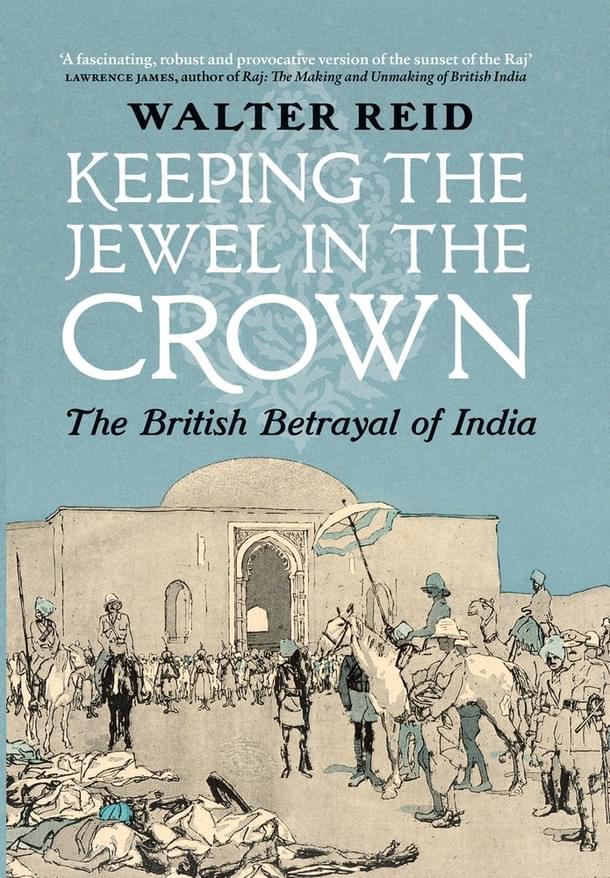Magazine
1917-1947: The Climax Of The Raj’s Plunder Of India
Jay Bhattacharjee
Jun 05, 2017, 05:38 PM | Updated 05:38 PM IST
Save & read from anywhere!
Bookmark stories for easy access on any device or the Swarajya app.


Walter Reid. Keeping the Jewel in the Crown: The British Betrayal of India. Penguin Random House India. 2017.
In the last few years there has been a spate of books and research publications on the twilight period of the Raj in India, as well as the residues the Empire left behind in independent India or bequeathed to the young nation-state.
This book by a British political and military historian hit the shelves last year but does not seem to have gathered the traction it deserved. In India there have been a couple of reviews and one in an American daily. In Britain itself, the book does not seem to have elicited the attention it legitimately deserves. The obvious reason that springs to mind is that the British establishment finds it uncomfortably close to the truth.
The bottom line is that Reid rips off the comfortable façade that has been put in place carefully for so many decades by the votaries of Pax Britannica. And he does this with a ruthless precision and an attention to detail that should be a lesson to professional historians and social scientists.
The important thing to remember, as the author points out himself, is that this not a book on Indian history, nor an account of the independence movement. This is an assessment of British policies that affected India. As a national of the occupying imperial power, Reed’s elegant mea culpa is that Britain did not discharge its primary “duty of trusteeship”, which was to bring India up to a position where it could manage its own destiny.
The human cost of Britain’s failure is juxtaposed against the crimes of Nazi Germany, though the author, here, steps back from crossing the line. He says that Pax Britannica did not match the evil or the motivation of the German Third Reich, but this writer would argue that the Bengal Famine, by itself, puts Britain in the same league as the Hitler gang. We will come back to this later.
Reid’s study confines itself to the last 30 years of the Raj, from 1917, when the Montagu Declaration was announced, till August 1947, when the old India was torn asunder. To my mind, this is a logical choice and Reid convincingly demonstrates why this is so. This entire study, relatively concise in its 300 pages (as compared to other historical tomes), relentlessly demonstrates that Britain did little during this period of 30 years to prepare India to attain her destiny as an independent country.
While the old colonial country did have many people of goodwill and equity in its ruling establishment, most of the key figures, certainly among the Tories, were manifestly hostile to the very concept of an independent India. At best, they were indifferent. Churchill, predictably, emerges as the snake in the grass. As the book progresses, it is fascinating and revolting, in equal measure, to read how this odious man played such a despicable role in the entire saga. Wavering and inconsistent on many occasions, when it came to the nitty-gritty of the transfer of power, he was steadfastly hostile and inimical to the entire notion of an independent India. His virulent racism towards Indians was so patent in his official discussions, that even die-hard colonialists in the Conservative Party like Leopold Amery were appalled.
Getting back to the riveting recital of events in Reid’s book, the Montagu Declaration clearly was quite vague, whether deliberate or otherwise. The reference to an “eventual dominion status” did not specify when it would come about. It was equally opaque about whether India would be granted the same position as the white dominions like Canada and Australia as specified in the Statute of Westminster of 1931.
Reid points out quite correctly that the Montagu Declaration was followed by regressive steps like the Rowlatt Act that logically resulted in an abomination like the Jallianwalla Bagh massacre. It became increasingly clear in the 1920s and the 1930s that the British Empire and its ruling elite were not prepared to concede Indian independence either willingly or graciously. Lord Curzon harrumphed that the objective of the Raj was to leave “a little justice or happiness or prosperity, a sense of manliness or moral dignity, a spring of patriotism, a dawn of intellectual enlightenment or a stirring of duty where it did not exist before”. The man did not realise that four of his wishes or objectives (manliness, dignity, patriotism and intellectual enlightenment) would bring about the fall of the Raj sooner or later.
It must be noted that Curzon was an Oriental scholar of some eminence and among the most erudite of the British administrators in India. However, his Partition of Bengal had left a legacy that continued to haunt Hindu-Muslim relations till 1947. Reid admits honestly that Curzon’s successors found it convenient to use the “divide and rule” stratagem whenever the independence movement gained steam and it became useful to pit one community against the other. The book also confirms what many other studies and accounts of the Indo-British interface have demonstrated over many years, namely that the British ruling junta in India clearly preferred the Muslims to the Hindus.
The Montagu Declaration, however vague, was followed by the Montagu-Chelmsford reforms in 1919. Some of the interesting results of this included a quantum jump in the number of Indian members of the Viceroy’s Executive Council to three out of seven (from zero earlier) to the decision to hold ICS examinations in Delhi as well as in London. Eleven provinces would have their own legislatures and there would be a central one, of course. Safe portfolios were given to elected Indians in the provinces, while there was a reserved list which only the Viceroy administered. Interestingly, even these limited reforms were opposed by Britons who had either financial interests or were former Raj officials. They formed an Indo-British Association to oppose all concessions to Indians.
There was an interesting interlude between 1922 and 1926, when Chelmsford was succeeded by Reading as the Viceroy. Before becoming the first Marquess of Reading, the man was Rufus Isaacs, from a Spanish Jewish family that had emigrated to Old Blighty. He had a colourful career before he made his name as an immensely successful barrister. He arrived in India with good intentions, convinced that racial discrimination was a major flaw in the imperial framework. He initially did not play the divide and rule game and even went to the extent of warning Whitehall about its latent dangers, but he too succumbed to the compulsions of safeguarding the empire.
With the arrival of Irwin in Raisina Hill in April 1926, the closing chapters of the Raj began. Till the Union Jack was lowered on 15 August 1947, Pax Britannica saw five Lat Sahebs ruling over us. They were Irwin, Willingdon, Linlithgow, Wavell and Mountbatten. As Reid says, some were “more able than others, two were not able at all”, but they all mattered because of the gaddi they occupied. Irwin arrived with great goodwill for Indians and, according to Reid, had more genuine sympathy for India’s hopes than any Viceroy until Wavell.
However, empathy with India went hand in hand with a fierce commitment to keep the Raj in India. Irwin’s stance gradually became more nuanced, but he had a determined opponent in Churchill’s best friend, Birkenhead, the Secretary for India. This diehard imperialist, according to Irwin, had a timetable of 600 years for Indian independence.
Unfortunately, Irwin was compelled to agree with Birkenhead on excluding Indians from the Simon Commission that visited India in February 1928.
The entire affair was a fiasco; Indians flooded the streets in demonstrations to oppose the farcical trip. Irwin reported to Birkenhead that Simon spent more time playing golf than doing anything worthwhile. The Viceroy’s epic comment: Simon spent half an hour looking for each ball he lost on the golf course. Understandably, the Commission’s report submitted in June 1930 was a non-starter. It had, in any case, been overtaken by the Irwin Declaration in October 1929, which again was so waffling that it meant little. Later events unfolded predictably. The Gandhi-Irwin Pact of March 1931, after the usual hiccups that these arrangements go through, was also hyped initially by both sides. The usual villains in Westminster and in the corridors of power in Britain saw to it that it ended ignominiously.
The second Round Table Conference in London between September and December 1931 was merely a pleasant interlude to the events that led to the enactment of the Government of India Act in 1935. Whether we like to face the fact or not, this British statute formed the bedrock of independent India’s republican constitution that came into force 15 years later. Therefore, Reid does a favour to us when he crisply recounts the tortuous route in the run-up to the Act’s coming into force.
Churchill and the Tories did their best to derail the process in the Commons. Although the Act had, and continues to have, many defendants, including some in our shores, it was manifestly designed to preserve British rule in India for a generation, “perhaps even permanently”, according to Reid. Churchill’s shenanigans in his opposition to the Bill in the Commons would have done credit to any of the legislators we have had recently in some of our state assemblies.
In any case, the Act when it came into force was virtually a dead duck. It contained no reference to dominion status or eventual independence in any form. It also had debilitating provisions that hobbled the powers of the elected government. Defence was outside the latter’s purview and the civil service, including the police, enjoyed blanket protection.
Fast forward to the war and Britain’s realisation that India was much too critical a pivot in Britain’s war effort and therefore some attempts had to be made to placate the demands and aspirations of the Indians. This is easily the most interesting segment in the book and has to be read in order to grasp the abominable conduct of Pax Britannica in its dying moments. The Indian politicos are also nearly as bad as their imperial masters. And it is a Britisher who rips apart the façade. Everyone comes out poorly, except the soldier Wavell.
Perfidious Albion and most of its leaders are exposed mercilessly. In a bizarre and ridiculous idea, the Churchill gang even contemplated Britain holding on to the area around Delhi after independence. The Commonwealth charade is also revealed, with details about how India would continue to be tied to the old imperial apron strings. This certainly provides an insight to one of the most risible ideas that the Indian leadership under Nehru thrust upon the independent Indian nation.

The two caveats this writer has about this remarkable study is Reid’s exoneration of Churchill from any guilt in the case of the Bengal famine and his dismissive stance vis-a-vis Netaji and the INA. After Madhusree Mukherjee’s seminal study on the genocide unleashed on Bengal by the execrable Winston (Churchill’s Secret War: The British Empire and the Ravaging of India during World War II, 2011), it is impossible to buy Reid’s verdict on this issue. On the INA and Netaji, Attlee’s observations are now well substantiated and it is just not possible to relegate Netaji and the INA to a minor role, as Reid has done.
The final words should belong to the author of this seminal work: Was the 15th August 1947 “the honourable discharge of a great fiduciary responsibility? Or was it the end of a shabby tale of procrastination, and deceit, an end that was cobbled together in panic and despair?”
Jay Bhattacharjee is a policy and corporate affairs analyst based in Delhi.





